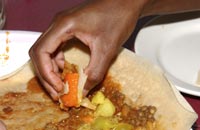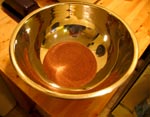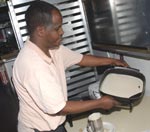
|
|


Injera
is not only a kind of bread—it’s also an eating
utensil.
In
Ethiopia and Eritrea, this spongy, sour flatbread is used
to scoop up meat and vegetable stews.
Injera
also lines
the tray on which the stews are served, soaking up their juices
as the meal progresses. When this edible tablecloth is eaten,
the meal is officially over.
Injera
is made with
teff,
a tiny, round grain that flourishes
in the highlands of Ethiopia. While teff is very nutritious,
it contains practically no gluten. This makes teff ill-suited
for making raised bread, however
injera
still takes
advantage of the special properties of yeast. A short period
of fermentation gives it an airy, bubbly texture, and also
a slightly sour taste.

|
|
Injera
|
Ethiopian
and Eritrean immigrants have modified their recipes after
moving to the United States or Europe, depending on what grains
are available to them. The
injera
you find in many
East African restaurants in the United States includes both
teff and wheat flours. Most
injera
made in Ethiopia
and Eritrea, on the other hand, is made solely with teff.
Recipe
Conversions
|
 CAUTION
CAUTION
Kids, please don’t try this at home without the help
of an adult.
 Tip
Tip
Depending on where you live, teff flour can be difficult to
come by. Try a well-stocked health food store.
|
|
|
|
|
What
Do I Need?
|
|

|
|
Teff
grain
|
•
1/4 cup teff flour
• 3/4 cup all-purpose flour
• 1 cup water
• a pinch of salt
• peanut or vegetable oil

•
a mixing bowl
• a nonstick pan or cast-iron skillet
|
 Tip
Tip
If
you have teff grain instead of flour, first grind it in a clean
coffee grinder, or with a mortar and pestle.
|
|
|
|
|
What Do I Do?
|
|
|
1.
Put the teff flour in the bottom of a mixing bowl, and sift in the all-purpose flour.
2.
Slowly add the water, stirring to avoid lumps.
3.
Put the batter aside for a day or more (up to three days) to allow it to ferment. In this time, your
injera
batter will start to bubble and acquire the slight tanginess for which it’s known. Note: If you find that your
injera
batter does not ferment on its own, try adding a teaspoon of yeast.
4.
Stir in the salt.
5.
Heat a nonstick pan or lightly oiled cast-iron skillet until a water
drop dances on the surface. Make sure the surface of the pan is smooth: Otherwise, your
injera
might fall apart when you try to remove it.
6.
Coat the pan with a thin layer of batter.
Injera
should be thicker than a crêpe, but not as thick as a traditional pancake. It will rise slightly when it heats.

7.
Cook until holes appear on the surface of the bread. Once the surface is dry, remove the bread from the pan and let it cool.
|
 Did
You Know?
Did
You Know?
Teff is extremely high in fiber, iron, and calcium.
 Tip
Tip
Many Ethiopians in America use square-shaped, electric, nonstick
pans. These heat evenly and make it easy to remove the
injera
once it is cooked.
 Did
You Know?
Did
You Know?
Teff is the smallest grain in the world. It takes about 150
teff seeds to equal the weight of a kernel of wheat!
|
|
|
|
|
What’s
Going On?
|
|
|
If
you’ve ever cooked pancakes, making
injera
might
seem familiar. In both cases, tiny bubbles form on top as
the batter cooks. Keeping an eye on these bubbles is a great
way to see how close the pancake or
injera
is to being
ready without peeking underneath.
These
bubbles come from the carbon-dioxide produced by the leavener—usually
baking powder or soda in the case of pancakes, “wild”
yeast in the case of
injera
. Neither batter contains
much gluten. Most pancake recipes tell you not to mix the
batter too much: If you do, gluten will develop, making them
too chewy. Teff, the grain used to make
injera
, contains
very little gluten to begin with. In both cases, the result
is the same: With no gummy substance to “blow up,”
most of the carbon-dioxide from the leaveners rapidly escapes
into the air, leaving the little popped bubbles that contribute
to the distinctive textures of these breads.
|
|
|
|
|
|
What
Else Can I Try?
|
|
|
• You can experiment by adjusting the ratios of wheat
and teff flours in your recipe, or by adding another type
of flour altogether. You can also let your batter ferment
for more or less time, depending on how sour you like your
injera
to be.
•
To see for yourself how little gluten there is in teff, try
kneading some teff flour into a ball of dough. (You might
also include teff flour in the
gluten
ball activity
). You’ll get very different results
than when you use wheat flour.
|
|
|
|
|

|
